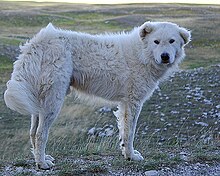Pastore Maremmano-Abruzzese

A working Maremmano on the Gran Sasso of Abruzzo, Italy
|
||||||||||||||||||||
| Other names | Cane da Pastore Maremmano-Abruzzese Pastore Abruzzese Pastore Maremmano Abruzzo Sheepdog Abruzzese Sheepdog |
|||||||||||||||||||
|---|---|---|---|---|---|---|---|---|---|---|---|---|---|---|---|---|---|---|---|---|
| Common nicknames | Maremma, Maremmano, Abruzzese sheepdog | |||||||||||||||||||
| Origin | Italy | |||||||||||||||||||
|
||||||||||||||||||||
| Notes | Pastore Maremmano-Abruzzese – Italian Breed Standard | |||||||||||||||||||
| Domestic dog (Canis lupus familiaris) | ||||||||||||||||||||
| Classification / standards | |||
|---|---|---|---|
| FCI | Group 1, Section 1 Sheepdogs #201 | standard | |
| ANKC | Group 5 (Working Dogs) | standard | |
| KC (UK) | Pastoral | standard | |
| NZKC | Working | standard | |
| UKC | Guardian Dog | standard | |
The Maremma Sheepdog or Maremmano-Abruzzese Sheepdog (Italian: Cane da pastore Maremmano-Abruzzese), usually referred to simply as the Maremmano or Abruzzese Sheepdog, is a breed of indigenous to central Italy, particularly to Abruzzo and the Maremma region of Tuscany and Lazio. It has been used for centuries by Italian shepherds to guard sheep from wolves. The literal English translation of the name is "The dog of the shepherds of the Maremma and Abruzzese region". The English name of the breed derives from that of the Maremma marshlands, where, until recently, shepherds, dogs and hundreds of thousands of sheep over-wintered, and where the breed is today abundant although sheep-farming has decreased substantially. The breed is widely employed in Abruzzo, where sheep herding remains vital to the rural economy and the wolf remains an active and protected predator. Similar breeds include the Pyrenean Mountain Dog, the Kuvasz of Hungary, the Tatra of Poland, the Cuvac of Slovakia and the Šarplaninac (although not white), with all of which it may share a common ancestor; and the Akbash Dog of Turkey.
Descriptions of white sheep defense dogs are found in ancient Roman literature, in works such as those of Columella, Varro and Palladius. Similar dogs are depicted in numerous sculptures and paintings from Roman times to the present. Among the earliest is the series of large statues (two in Rome, one in Florence, one – the Duncombe Dog – in England) copied from a Hellenistic bronze from Pergamon. Iconographic sources that have been identified as relevant to the history of the Maremmano include:
...
Wikipedia
